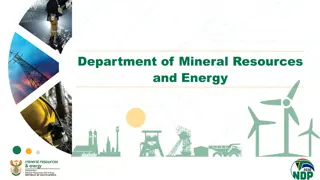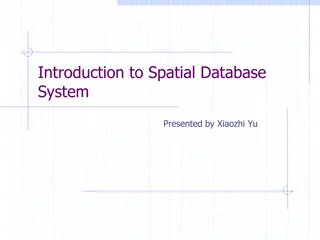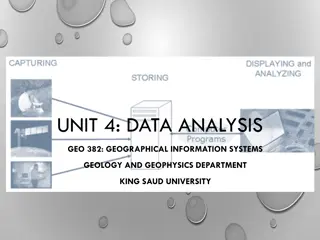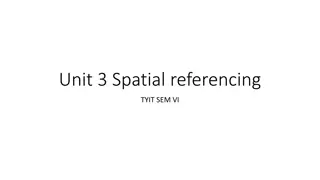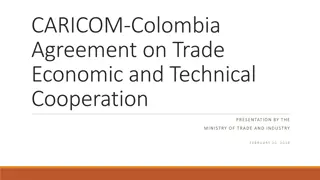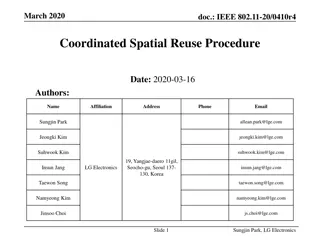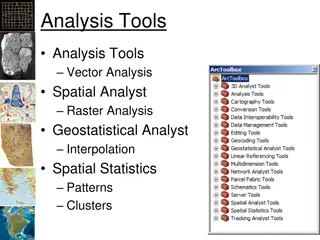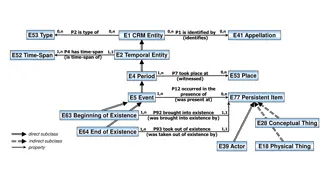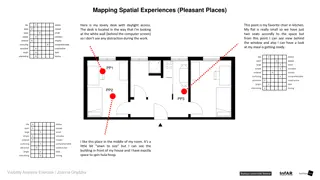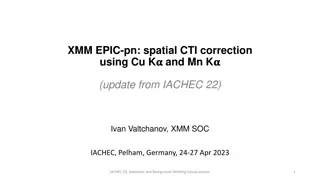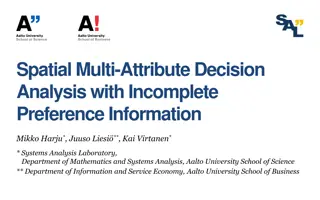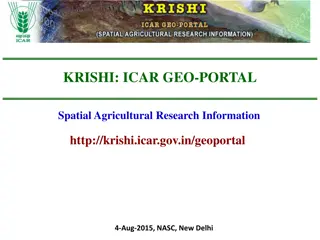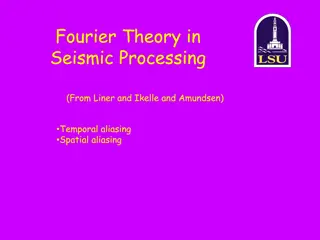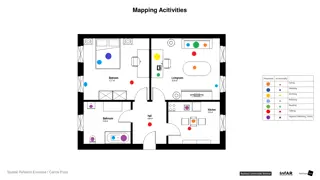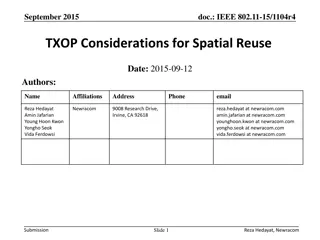WISK: A Workload-aware Learned Index for Spatial Keyword Queries
WISK, a workload-aware learned index that combines spatial and keyword queries to efficiently retrieve objects. It integrates spatial and textual indexes and considers query workload information.
1 views • 17 slides
fMRI Coregistration and Spatial Normalization Methods
fMRI data analysis involves coregistration and spatial normalization to align functional and structural images, reduce variability, and prepare data for statistical analysis. Coregistration aligns images from different modalities within subjects, while spatial normalization achieves precise anatomic
3 views • 35 slides
Coregistration and Spatial Normalization in fMRI Analysis
Coregistration and Spatial Normalization are essential steps in fMRI data preprocessing to ensure accurate alignment of functional and structural images for further analysis. Coregistration involves aligning images from different modalities within the same individual, while spatial normalization aim
6 views • 42 slides
Localised Adaptive Spatial-Temporal Graph Neural Network
This paper introduces the Localised Adaptive Spatial-Temporal Graph Neural Network model, focusing on the importance of spatial-temporal data modeling in graph structures. The challenges of balancing spatial and temporal dependencies for accurate inference are addressed, along with the use of distri
4 views • 19 slides
Introduction to Spatial Data Mining: Discovering Patterns in Large Datasets
Spatial data mining involves uncovering valuable patterns from extensive spatial datasets, offering insights into historical events, environmental phenomena, and predictive analytics. Examples range from analyzing disease outbreaks to predicting habitat suitability for endangered species. The applic
2 views • 20 slides
Acceptance of Amended AFRA Agreement in Parliament: Overview
The presentation outlines the purpose, background, strategic importance, amendments, status, risks, and recommendations associated with the acceptance of the Amended African Regional Co-operative Agreement for Research, Development, and Training Related to Nuclear Science and Technology (AFRA Agreem
1 views • 12 slides
Advanced Techniques in 3D Scene Analysis for Spatial Understanding
Cutting-edge research in 3D scene analysis focuses on sequenced predictions over points and regions for comprehensive spatial understanding. The approach involves contextual classification, overcoming limitations of classical graphical models through innovative inference machines that prioritize tra
0 views • 40 slides
Spatial Database Systems: An Overview
This presentation by Xiaozhi Yu introduces the fundamentals of spatial database systems, covering topics such as spatial data types, relationships, system architecture, modeling, and organizing underlying spaces. It delves into the importance of integrating geometry into DBMS data models, spatial in
2 views • 30 slides
Spatial Distortion Correction in EPI Sequences: Field Mapping Examples
Spatial distortion artifacts in EPI sequences (BOLD or DWI) due to slow sampling rates in the phase encoding direction can be corrected using B0/spatial field mapping techniques. This correction requires obtaining field maps under the same B0 shimming conditions and with identical FoV and adjustment
2 views • 4 slides
Spatial Analysis in GIS for Effective Decision-Making
Spatial analysis in GIS involves modeling geographic problems, processing data, and exploring results to understand spatial relationships, patterns, and suitability for various purposes. GIS tools offer unique capabilities for handling geographically referenced data, data entry, storage, manipulatio
3 views • 21 slides
Spatial Referencing Systems for Mapping
Spatial reference systems play a crucial role in defining geographic parameters and coordinate systems for mapping. They consist of components like orientation, latitude, longitude, and elevation, which help in representing spatial properties on maps. Reference surfaces such as the Geoid and ellipso
5 views • 13 slides
Collective Agreement Highlights for CUPE Local 716 Richmond School District 38 (2022-2025)
The collective agreement outlines wage increases based on the Provincial Framework Agreement for the years 2022-2025, includes updates on equity and inclusion with a focus on no discrimination, addresses para-educators' hours of work and overtime, revises standby allowances, and introduces a new pro
0 views • 34 slides
Overview of CARICOM-Colombia Trade Agreement
Presentation by the Ministry of Trade and Industry on the CARICOM-Colombia Trade, Economic, and Technical Co-operation Agreement, covering key facts, trade with Colombia, non-tariff barriers, and ways to address additional market access under the agreement. The agreement, signed in 1994, aimed to en
1 views • 16 slides
IEEE 802.11-20/0410r4 Coordinated Spatial Reuse Procedure
This document presents the Coordinated Spatial Reuse (CSR) procedure in IEEE 802.11-20/0410r4, focusing on the transmission schemes and necessary information for effective spatial reuse. It outlines the topology of CSR environments, acquisition of information for CSR, CSR capability announcement by
10 views • 23 slides
Spatial Analysis & Modeling for Spatial Planning Training in Maputo, Mozambique
Explore spatial analysis techniques for efficient route planning, site selection, pattern identification, and value prediction in the context of spatial planning. Learn about surface modeling, relationships among features, and the importance of spatial modeling in addressing geographical problems.
0 views • 27 slides
GIS Data Models for Spatial Planning Training in Maputo, Mozambique
Explore the concepts of GIS data models including vector vs. raster, spatial relationships, spatial operations, and representation of real-world entities in a spatial database. Understand how spatial data models are used to manipulate spatially-referenced information and define the spatial location
1 views • 32 slides
Spatial Autocorrelation in Geostatistical Analysis
Explore the concept of spatial autocorrelation, its implications in geostatistical analysis, and the importance of detecting and interpreting it correctly. Learn about auto-correlation, signal components, correlation significance, and measuring autocorrelation using tools like Moran's I. Gain insigh
1 views • 12 slides
Future Directions for GIS in Samoa
Enhancing GIS practices in Samoa involves establishing a Samoa GIS User Group, improving spatial data management, developing a national spatial data infrastructure framework, and implementing GIS applications in various sectors like emergency response, public access, and natural resource management.
3 views • 12 slides
Spatial Relation Switching Requirements in 3GPP NR RAN Plenary Meeting
The document discusses various spatial relation switching requirements for uplink scenarios in the 3GPP NR RAN Plenary Meeting. It covers agreement points related to UL SRS, PUCCH, P-SRS, and DL-RS, defining delay requirements and known conditions for spatial relation switching. The agreements provi
0 views • 11 slides
Spatial Stream Allocation in IEEE 802.11-20 Trigger Frames
The document discusses spatial stream allocation in IEEE 802.11-20 trigger frames, specifically focusing on the SS Allocation subfield. It explains how trigger frames allocate resources for TB PPDU transmissions and solicit User Info fields, detailing the RU Allocation and SS Allocation subfields. T
4 views • 15 slides
CARICOM-Costa Rica Free Trade Agreement Overview Presentation
This presentation highlights key facts and trade information between Trinidad and Tobago and Costa Rica, focusing on the CARICOM-Costa Rica Free Trade Agreement signed in 2004. It covers trade statistics, benefits, issues facing exporters, and the nature of the agreement. The agreement includes tari
1 views • 13 slides
Private Social Services Sector Collective Agreement Summary 2023-2025
The Private Social Services Sector Collective Agreement effective from 1 May 2023 to 31 December 2025 includes a 3.6% general raise in 2023, varied minimum salary scale increases across competence groups and service steps, and one-time instatement payments for different employee categories in 2024.
0 views • 19 slides
Temporal and Spatial Information Models
This content delves into the intricacies of temporal and spatial information models, covering concepts such as existence, presence, and spatiotemporal relationships. It explores how entities are identified, events are witnessed, and durations are defined within these models. The interplay between ti
4 views • 9 slides
EMC Tar-Pamlico Phase IV Agreement Water Quality Committee Details
The EMC Tar-Pamlico Phase IV Agreement entails nutrient control for Tar-Pamlico point sources initiated in 1990. The agreement focuses on performance goals, funding, BMPs, and management strategies. It addresses parties, basin association members, and key changes in the Phase IV agreement. Various a
0 views • 10 slides
Coordinated Spatial Nulling (C-SN) Simulations in IEEE 802.11-24/0012r0
The document discusses the concept of Coordinated Spatial Nulling (C-SN) in IEEE 802.11-24/0012r0, focusing on spatial nulling feedback, synchronization needs, advantages of partial nulling, and comparison of half-coordinated versus fully coordinated scenarios. Simulation results are presented, anal
0 views • 19 slides
Enhancing Spatial Data Analysis in QGIS
Explore the integration of relational databases with QGIS to facilitate efficient spatial data analysis. Discover the importance of recognizing spatial relationships within data sets and the solutions to enhance QGIS for relational datasets. Overcome challenges and delve into the intersection and su
0 views • 25 slides
Spatial Experiences in a Small Flat
Mapping spatial experiences in a small flat, this content describes pleasant and unpleasant places within the living space. It highlights favorite spots like a kitchen chair with a view, a cozy desk for work, and a room with enough space for activities. In contrast, it mentions bothersome areas like
0 views • 10 slides
Marine Spatial Data Infrastructures Report Overview
The report provides insights into the activities and discussions at the EAHC-MSDIWG1 meeting held in Busan, ROK. It outlines the key agenda items, country reports on national MSDI, membership details, importance of MSDI, and trends in marine spatial data. The report emphasizes the significance of ma
0 views • 11 slides
Analysis of MIMO for IMMW Transmission in IEEE 802.11-24
Proposal discusses the suitability of MIMO for IMMW transmission under different scenarios. The analysis focuses on the number of spatial streams based on channel rank and quality, recommending dual-polarization for LOS paths supporting 2 spatial streams and spatial separation for larger devices sup
0 views • 16 slides
XMM EPIC-pn Spatial CTI Correction using Cu K? and Mn K?
Detailed procedures for spatial CTI correction using Cu K? and Mn K? in XMM EPIC-pn detectors, including applying long-term CTI corrections, stacking event lists, extracting spectra, fitting Cu K line, and deriving spatial offsets. Examples show improvements in velocity space after corrections. Vali
0 views • 18 slides
Spatial Multi-Attribute Decision Analysis with Incomplete Preference Information
In this study by Mikko Harju, Juuso Liesi, and Kai Virtanen from Aalto University, the focus is on spatial decision analysis for scenarios where decision alternatives have varying consequences across a geographical region. The research delves into the significance of spatial value functions in repre
0 views • 19 slides
Canada-First Nation Education Jurisdiction Funding Agreement Overview
Overview of the Canada-First Nation Education Jurisdiction Funding Agreement, including key agreements, funding structure, and approval processes between Canada and Participating First Nations. This presentation highlights the Sectoral Self-government Agreement and the role of Chief and Council in r
0 views • 32 slides
Oklahoma Multi-Agency Data Sharing Agreement Overview
The Oklahoma Multi-Agency Data Sharing Agreement facilitates streamlined data exchanges among nine state agencies. The agreement aims to maximize client benefits, increase efficiencies, and regulate government programs. Participating agencies include Oklahoma HHS Cabinet Agencies, State Department o
0 views • 16 slides
Intergroup Agreement and Disagreement Measures in Biostatistics
This presentation by Madhusmita Panda, an Associate Biostatistician at Cytel, discusses the importance of measuring intergroup agreement and disagreement in statistical analysis. The content covers various measures available in literature, intuitive approaches for measurement, and includes a hypothe
0 views • 19 slides
Practical English Lessons on Giving Directions and Spatial Relations
Engage in interactive English learning with topics covering asking for directions, city landmarks, spatial relations, and more. Understand key phrases for seeking directions and explore a city map to navigate locations using descriptive spatial terms. Enhance your language skills with practical exer
0 views • 17 slides
ICAR KRISHI Geo-Portal: Spatial Agricultural Research Information
ICAR KRISHI Geo-Portal is a digital platform aiming to facilitate spatial agricultural data generation, compilation, visualization, and analysis. It hosts spatial databases, provides map services, and allows data sharing across platforms. The portal, developed using open-source technologies, offers
1 views • 32 slides
Fourier Theory in Seismic Processing
Fourier theory plays a crucial role in seismic processing by helping to avoid temporal and spatial aliasing. It emphasizes the importance of sampling rates for accurate waveform reconstruction and highlights the significance of oversampling to prevent aliasing issues. Spatial aliasing is discussed i
0 views • 18 slides
School-to-School Partnership Agreement
This agreement outlines a partnership between two schools, where one school commits to supporting and assisting the other school in reaching its full potential. Through this agreement, the schools aim to benefit the community as a whole by working together in curriculum implementation and school-bas
0 views • 12 slides
Spatial Analysis of Apartment Layout by Carlos Pozo
Carlos Pozo conducted a spatial analysis of an apartment layout, focusing on centrality, distances from the entrance, and spatial relations between different activities. The findings highlight how the design influences human behavior and privacy within the living space.
0 views • 4 slides
IEEE 802.11-15/1104r4: Optimizing CCA Threshold for Spatial Reuse in WLANs
The document discusses considerations for optimizing the Clear Channel Assessment (CCA) threshold in wireless local area networks (WLANs) to enhance spatial reuse efficiency. It emphasizes minimizing over-protection caused by the current CCA rule while addressing factors like frequency reuse, BSS/OB
0 views • 18 slides





